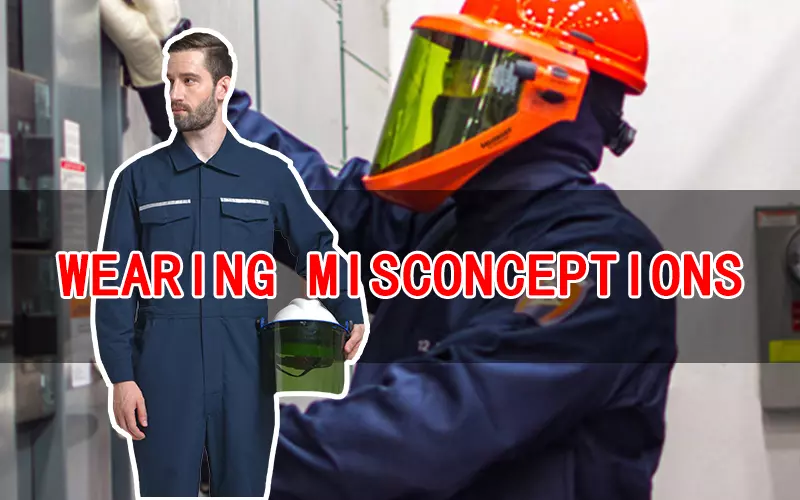Shanghai, China
+86-17317656853
inquiry@cgprotection.com



— Small Errors That Can Lead to Major Consequences**
Arc flash incidents are extremely destructive, with temperatures exceeding 19,000°C, pressure waves strong enough to knock workers off their feet, and vaporized metal capable of penetrating skin instantly. In such high-risk environments, even if a worker is wearing arc-rated clothing, incorrect wearing practices can severely reduce protection or even render the protection ineffective.
Below are the five most common mistakes observed in the power, energy storage, photovoltaic, and industrial maintenance sectors, along with their consequences and best practices.
Incident analyses show that over one-third of upper-body burn injuries occur because closures were not fully secured, such as:
A partially open collar
A zipper not pulled to the top
Buttons left unfastened
Loose cuffs
These small gaps become “heat entry points,” allowing hot gases to reach the skin during an arc flash.
Localized deep burns
High-temperature gases rushing into the chest and neck
Injuries far exceeding the size of the opening
Second- and third-degree burns
All zippers, buttons, and Velcro closures must be fully secured with no gaps at the collar or front opening.
Many workers wear quick-dry shirts, athletic wear, polyester undergarments, or printed T-shirts under their arc flash suits.
This is extremely dangerous.
Arc flash temperatures cause synthetic fibers to melt instantly and bond to the skin, creating severe, hard-to-treat injuries.
Molten material embedding into the skin, requiring surgical removal
Deep burns with high infection risk
Long recovery times lasting months or even a year
More severe than skin exposed without clothing
The base layer must be 100% cotton or arc-rated, with no synthetic components.
Too loose:
Creates a “chimney effect,” allowing hot gases to flow into the clothing and cause internal burns.
Too tight:
Reduces the air insulation layer, increases heat transfer, and restricts movement during emergency response.
Internal burns more serious than external burns
Restricted mobility during accidents
Reduced protective performance by 20–40%
Ensure the suit fits properly—allowing a suitable air gap for insulation without being baggy.
Some workers only wear arc flash clothing but neglect head, hand, face, or foot protection, such as:
Using a regular hard hat instead of an arc-rated helmet/hood
Wearing general-purpose gloves instead of arc-rated or insulated gloves
Wearing normal sports shoes
Using non–arc-rated face shields or no shield at all
These weak points often become the first to sustain injury.
Facial and eye injuries from intense light and heat
Severe hand burns affecting long-term function
Foot injuries caused by molten metal penetration
Metal accessories (watch, belt, zippers) heating instantly and acting as “localized branding irons”
Use a complete arc flash PPE system: suit, gloves, face shield, helmet, and footwear—none can be omitted.
Many power, PV, and energy storage workers cannot accurately evaluate the incident energy level, leading to the selection of insufficient PPE.
When the job’s energy exceeds the clothing’s ATPV/EBT rating, the suit cannot stop the heat.
Thermal energy breaks through the clothing
Protection fails instantly
Serious burns even when wearing arc-rated clothing
Ensure:
PPE Arc Rating ≥ Incident Energy (cal/cm²)
For example:
4 cal/cm² → ARC 1 minimum
8 cal/cm² → ARC 2 minimum
25 cal/cm² → ARC 3/ARC 4 required
Arc flash clothing is not simply “put it on and go”—it is a complete, precise, and highly engineered protective system.
Even small deviations in how it is worn can reduce protection by 50% or cause total failure.
Every button, every zipper, every layer matters.
Correct wearing is the most basic—and most critical—form of self-protection.
Tags:
Shanghai C&G's personal protective clothing and PPE products are trusted by customers in the world. Our products are exported worldwide, with a strong presence in the United States, China, Japan, Germany, the United Kingdom, India, France, Italy, Brazil, and Canada. In addition, we have a significant customer base in other countries across each continent, including Australia, New Zealand, South Africa, Nigeria, and Egypt in Africa; Argentina, Chile, and Mexico in South America; Russia, South Korea, and Indonesia in Asia; Spain, Poland, and Turkey in Europe; and Saudi Arabia and the United Arab Emirates in the Middle East. Wherever you are in the world, we have the products you need to stay safe and protected. Contact us today to learn more about our products and how we can help you meet your safety needs.










© 2023 Shanghai C&G. All Rights Reserved.